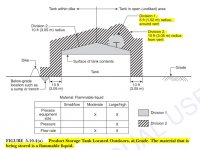ericwg
Member
- Location
- Sacramento, CA
- Occupation
- Associate Electrical Engineer
First, a brief summary RE: the situation I'll be asking about. I am doing the electrical design for a multi-building site (in CA) for which the design is mostly commercial. One of the buildings has a mixed B/R2 occupancy. Providing fuel for an optional standby engine generator, HVAC, and some appliances is a pair of above ground 1,000 gallon LPG (cylinder) tanks. The piping for each tank goes underground immediately after leaving the tank, one routing to the generator, the other routing to the building. Per Article 6.4 of NFPA 58 I am aware that these tanks require a minimum spacing of 3ft from each other and 25ft minimum distance from buildings, a group of buildings, or the line of adjoining property that can be built upon. What I am having some trouble with is confirming the Class/Division rating and scope of classified area. I will state what I have come up with below. I would really appreciate feedback confirming whether you think I'm correct or not, and if not, providing relevant references backing your claim.
1) Class I / Division 2: The Class I rating is fairly obvious. While I believe this to be a Division 2 area, I have run across a few claims that it is Division 1. Per NFPA 497, the definition of a Class I, Division 2 area states (in short) that the material will be "...normally confined within closed containers from which they can escape only in case of accidental rupture or breakdown of such containers" or in which "...ignitable concentrations of flammable (material) are normally prevented by positive mechanical ventilation and which might become hazardous through failure or abnormal operation of the ventilating equipment". The LPG in these tanks should never make it outside of these tanks except in some kind of abnormal condition, as described previously. Even during filling, the system should be sealed with only a miniscule amount of vapor escaping. Bottom line, my high level understanding of the Division ratings is that Division 1 = normal, Division 2 = abnormal. Thus, I believe the Division 2 rating to be appropriate.
2) Definition of Classified Area Around Tank: When it comes to fuel dispensing, which I am also dealing with at this site, Figures 514.3 and 514.3(B) from NFPA 70 make it crystal clear what the classified area around the dispenser looks like. I am trying to ascertain what the classified area looks like around the LPG tanks. After digging deeper into NFPA 497 (2017), I came across Figure 5.10.4(a) - Product Storage Tank Located Outdoors, at Grade. The material that is being stored is a flammable liquid. I am attaching a snapshot of that figure. Of all the figures in NFPA 497, this one really looks like it best applies to my situation. If I am reading the figure correctly, it basically states that the classified area extending 10ft out from the surface of the tank and in a 10ft radius around the vent would be Division 2, while the area in a 5ft radius around the vent would be Division 1. Since there are no sumps or trenches around my tanks, the classified area would only exist above grade. If true, as long as I keep any electrical wiring at minimum of 10ft from the surface of the tanks or have it below grade, it should not need to adhere to Article 500 requirements.
Correct? Thanks for reading.
-Eric
1) Class I / Division 2: The Class I rating is fairly obvious. While I believe this to be a Division 2 area, I have run across a few claims that it is Division 1. Per NFPA 497, the definition of a Class I, Division 2 area states (in short) that the material will be "...normally confined within closed containers from which they can escape only in case of accidental rupture or breakdown of such containers" or in which "...ignitable concentrations of flammable (material) are normally prevented by positive mechanical ventilation and which might become hazardous through failure or abnormal operation of the ventilating equipment". The LPG in these tanks should never make it outside of these tanks except in some kind of abnormal condition, as described previously. Even during filling, the system should be sealed with only a miniscule amount of vapor escaping. Bottom line, my high level understanding of the Division ratings is that Division 1 = normal, Division 2 = abnormal. Thus, I believe the Division 2 rating to be appropriate.
2) Definition of Classified Area Around Tank: When it comes to fuel dispensing, which I am also dealing with at this site, Figures 514.3 and 514.3(B) from NFPA 70 make it crystal clear what the classified area around the dispenser looks like. I am trying to ascertain what the classified area looks like around the LPG tanks. After digging deeper into NFPA 497 (2017), I came across Figure 5.10.4(a) - Product Storage Tank Located Outdoors, at Grade. The material that is being stored is a flammable liquid. I am attaching a snapshot of that figure. Of all the figures in NFPA 497, this one really looks like it best applies to my situation. If I am reading the figure correctly, it basically states that the classified area extending 10ft out from the surface of the tank and in a 10ft radius around the vent would be Division 2, while the area in a 5ft radius around the vent would be Division 1. Since there are no sumps or trenches around my tanks, the classified area would only exist above grade. If true, as long as I keep any electrical wiring at minimum of 10ft from the surface of the tanks or have it below grade, it should not need to adhere to Article 500 requirements.
Correct? Thanks for reading.
-Eric

